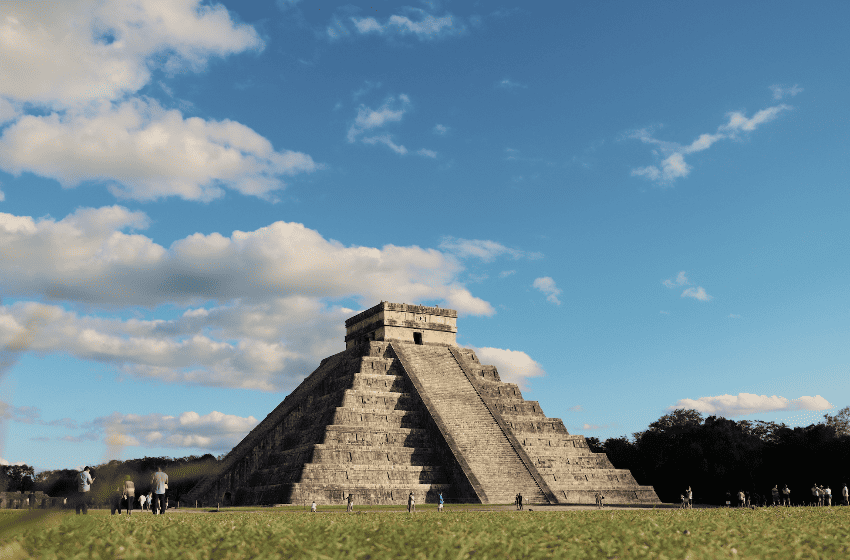How did the ancient Maya build their pyramids?

For over 3,000 years, the city-states that made up the Maya civilization dominated southern Mesoamerica, building majestic cities and towering pyramids in a hostile jungle habitat. Perhaps even more amazing is that they did so without using metal tools, wheels or beasts of burden to transport large limestone blocks from quarries in distant mountains to building sites. Instead, they did this with pure manpower.
“The Maya did not use the wheel nor draft animals, so they transported the building materials using person-power from the quarries to the building site,” Judith Maxwell, Professor of Linguistics and Anthropology at Tulane University told the Daily Herald in 2016.
Smaller blocks were carried by individuals with a tumpline, a backpack attached to the forehead with a leather strap, which places pressure on the spinal column rather than muscles, allowing people to bear heavier loads. Without the smelting techniques needed to forge iron, they devised chisels from jadeite and obsidian, which artisans used to create facade designs and to chunk out the stone blocks that supported awe-inspiring architecture.
A sophisticated network of causeways known as sacbeob (white roads, were intricately woven through the jungle and stood as symbols of immense political influence. They connected major cities and greatly increased the speed of transport of people and goods to support the rapid growth of the empire. Functioning as royal processional pathways connecting kingdoms – some stretch up to 60 miles in length – the sacbeob represented a remarkable engineering achievement comparable to the roads built by the Roman Empire. The ancient Maya strategically positioned sizable rocks on either side of the causeway, filling the intervening space with cobbles and smaller stones. The entire surface was then coated with stucco, a robust and sleek white plaster.
“Blocks were cut using stone tools only,” writes British historian Mark Cartwright. “Burnt-lime cement was used to create a form of concrete and was occasionally used as mortar, as was simple mud.”
The Maya also altered the landscape to navigate challenging terrains by elevating the ground with stones to maintain a level road. Traci Ardren, archaeologist and University of Miami professor of anthropology, told Miami media outlet News@TheU in 2020 that the Maya concocted a similar formula as the Romans used for concrete in the third century B.C. “[They] would have been a beacon through the dense green of cornfields and fruit trees,” Ardren said of the sacbeob. Archaeological evidence suggests the sacbeob likely played a pivotal role in fostering migration and prosperity through trade across the Yucatán Peninsula.
The ancient Maya were fascinated by the concepts of space and time, diligently studying the stars and aligning their cities with the intricate geometry of the heavens. Despite using basic tools, they demonstrated impressive precision in tracking stars and planets. The Caracol observatory in Chichén Itzá is perfectly aligned with the movements of Venus and solstices at the time. Seemingly irregularly placed windows in the observatory at the world-famous archaeological site capture the solar cycles of the closest planet to Earth. This enabled the creation of their highly accurate astronomical calendars, unparalleled in the ancient world. The Maya learned to predict eclipses, which they understood as illnesses among heavenly bodies and saw as dangerous to humans, employing rituals and talismans to protect themselves during these events.
“Buildings were constructed on precise plans according to such events as the winter and summer solstices and equinoxes,” writes Cartwright. “In addition, the outline of structures, when seen from above, was also deliberate and could form or resemble Maya glyphs for, for example, completion and time.”
He describes Maya sites as displaying evidence of deliberate urban planning, while monuments are often laid out on a radial pattern incorporating wide plazas. Topography usually determined where larger buildings were constructed. In contrast, buildings themselves were oriented along, for example, a north-south axis, and were positioned to take advantage of solar and other celestial events or sight lines.
Carving magnificent cities in one of the most inhospitable environments, numerous untouched Maya sites and their secrets remain concealed in the jungles stretching from Mexico to Honduras. The ancient city-state of Palenque in Chiapas has pyramids with hidden passageways and trap doors. One of them, the tomb of King Pakal, conceals an 80-foot stairway leading down inside. In a crypt measuring 30 feet in length and 23 feet in height, Pakal’s tomb held a massive 20-ton sarcophagus carved from a single piece of limestone.
“Pyramids were used not only as temples and focal points for Maya religious practices where offerings were made to the gods,” writes Cartwright. He writes that another function was as gigantic tombs for deceased rulers, their partners, sacrificial victims, and precious goods. Pyramids were also periodically enlarged so that their interiors, when excavated, sometimes reveal a series of complete but diminishing pyramids, often still with their original coloured stucco decoration. “In addition, individual shrines could be amalgamated into a single giant complex over time as Maya rulers attempted to impress their subjects and leave a lasting mark of their reign,” writes Cartwright.
Mark Viales writes for Mexico News Daily
Source: Mexico News Daily

